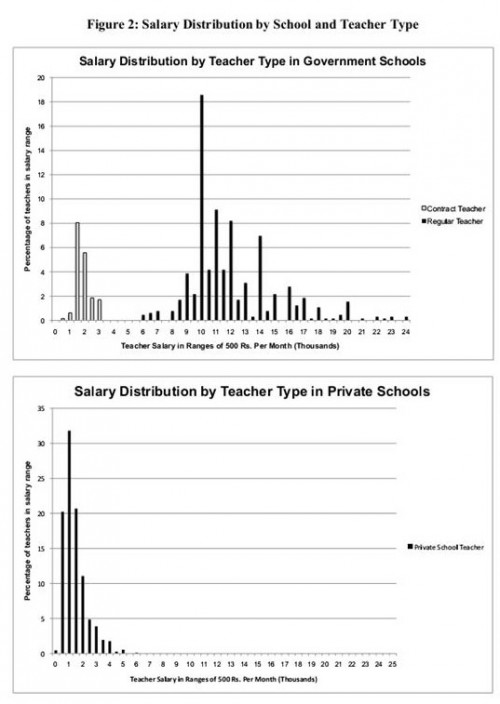Everyone complains about ‘failing’ state schools, but some countries are entitled to more of a gripe. State school teachers in a lot of countries just don’t show up for work, students in these schools can’t add and multiply despite years of schooling, and it’s really difficult to get rid of the absent teachers. So what do you do?
One way to improve learning that people have been writing about (see Duflo et al on Kenya or Kingdon and Atherton on India) is to hire more contract teachers. Hired on fixed-term contracts and without public sector job security (or access to public sector unions), these teachers are more likely to show up to school and their students do better. The problem is that this story just doesn’t seem to hold up consistently: in a large RCT in Andhra Pradesh by Muralidharan and Sundararaman, students didn’t do any better with contract teachers than regular teachers once reductions in class size were accounted for, even though the contract teachers were less likely to be absent from school. Also, in a recent RCT in Kenya by Bold et al, contract teachers do out-perform regular teachers, but only if they were hired and paid by NGOs and not the Ministry of Education! Are contract teachers just one in a line of hyped interventions that seem to have very limited generalizability?
Not really: across all these studies, contract teachers never do worse than civil service teachers, despite being younger, more inexperienced and more likely to not have had formal teacher training. In value-for-money terms, each contract teacher is at least four to five times as productive as a regular public service teacher: in Kenya, the average pay of a civil service teacher is $261 per month compared to $56 for a contract teacher. The problem is not that the contract teachers are being paid too little (they get paid salaries comparable to private school teachers in these countries) but that public sector employment just has a huge premium attached. In the Andhra Pradesh study, the authors present this graph of the salary distributions of each type of teacher:
In their own words: “private school teacher salaries are even lower than those of contract teachers and so much lower than regular teacher salaries, that there is almost no common support in the two distributions.”
The contribution of the Bold et. al. paper is to show that many gains in RCTs should be accepted only with caveats – the findings may not generalize even in the same contexts if the implementation differs a bit – something that’s been talked about for a while but it’s nice to have proof of. However, it shouldn’t really change our priors about contract teachers: governments don’t hire them because they’re better at teaching, they hire them because they’re cheaper and just as good– and nothing that has come out of any of these papers changes that.



Abhijeet – Thanks for this. I agree with your point about the appropriate benchmark for evaluating contract teachers. You get as much or more learning for less money by hiring contract teachers in both the Duflo et al Kenya paper and the Sundararaman & Venkatesh paper from AP. So the benefit-cost ratio = infinity. (Well, technically negative, but never mind.)
I have to disagree with your last sentence though.
In the Bold et al paper, we find ZERO effect of contract teachers hired by the government. Not relative to regular teachers. Just zero effect, full stop. Right alongside big, significant effects of the exact same program administered by an NGO.
So yes, I think this *should* dramatically “change our priors about contract teachers”, especially any attempt to scale them up as government policy.
More to the point, I think this should encourage us to talk less about the costs and benefits of “contract teachers” — as if they are a pill that can be prescribed in an institutional vacuum — and worry more about the scalability of NGO programs using contract teachers or the political viability of government programs using contract teachers.
I appreciate your optimism though!
Justin
Hi Justin,
Thanks for pointing this out. I had missed the fact that you report zero impact not only in the school fixed effects regressions (which would be similar to Muralidharan and Sundararaman) but also in the ITT regressions with no covariates – in this case then, contract teachers seem to add nothing at the margin as you correctly highlighted.
The major question is whether we know anything about how effective an additional civil service teacher would have been in this setting. If, for example, the binding constraint was the number of classrooms and not the number of teachers (not saying that this is the case!), then perhaps a civil service teacher may also have added nothing to learning outcomes i.e. the finding might be that an additional teacher adds nothing, regardless of tenure status. In which case the appointment of a contract teacher would still be preferable to the appointment of a civil service teacher. This is, I think, still of relevance: as civil service teachers retire, do we replace them with tenured posts or contract teachers?
The biggest challenge is, as you talk about at length in your paper, whether any large scale hiring of contract teachers is feasible given the political economy constraints. It has happened in several large Indian states and in states like Andhra Pradesh and UP a substantial chunk of the school teachers are contract teachers; of course, this says little about whether such a scheme might be feasible in other political contexts.
Do please comment here if I have missed something crucial again. Would be keen to hear what you think of this.
Abhijeet
Morning chaps.
Charlie Goldsmith, whom Abi and Lee will know from South Sudan, others perhaps not so much, here in Kinshasa, between trips to Freetown and Juba.
This jolly interesting stuff.
But I’m wondering – from a very practitioner-y point of view – how valuable it is to know that the performance (and, one might suspect, below that, attendance) of permanent+pensionable and contract teachers may be equally average in the absence, as there often is, of much in the way of management of performance and/or attendance.
And, by extension, whether the logical resulting action should be to seek to replace P+P staff with contract staff, or to do more about managing performance and/or attendance?
My colleagues in Sierra Leone have been supporting the Ministry of Health and Sanitation’s attendance management system for a couple of years, funded by DFID and now GF: nuts and bolts stuff of health facilities keeping daily attendance books, sending a paper summary up to Districts monthly, then Districts compiling and emailing (now uploading to website) return to the centre; spot checks that data matches at each level, and sanctions from the Centre on the serially absent. Clearly not impossible to beat the system, but a hopefully sensible start, and both the data and narrative reports from facility in-charges and District Health Management Teams suggest that attendance has improved materially in the last couple of years.
Last year we did a little piece of analysis for the Ministry of Health and Sanitation looking at the relationship between attendance and output, measured in terms of key standard activities for primary health units. Very much a first stab, seriously not Lancet stuff; a single month’s data to start with, and doing our best to control for natural differences in productivity between rural and urban clinics.
But it did seem to show that, at very least, output seemed to be correlated with attendance – which you would hope – and *some* suggestion that output was in more than linear proportion to attendance. The later doesn’t sound intuitively implausible: better managed clinics could have both stronger attendance and more efficient working; and more reliable attendance probably does drive more efficient working.
Clearly, this relationship is easier to analyse in systems like health and education that have reasonably quantifiable outputs than in, say, a big policy Ministry. But it would be very interesting to know if anyone else out there is doing work on attendance, and if they have found anything along the same lines.